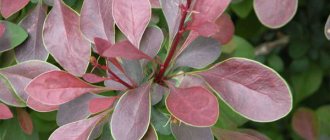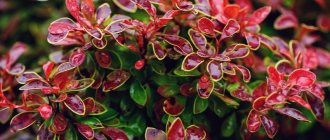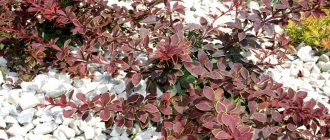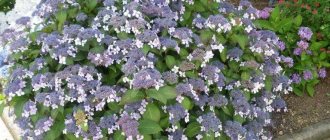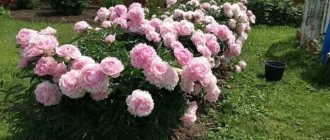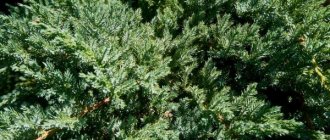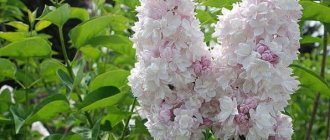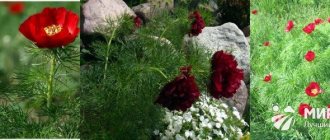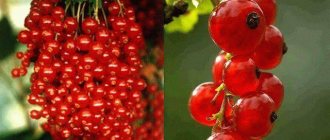The barberry variety Thunberg Maria was bred by Polish breeders specifically for cultivation in Russia. The result is a variety that tolerates cold winter temperatures and dry weather well, and also takes root well in a variety of soils.
If you follow simple rules of propagation and care, this beautiful ornamental variety will become a decoration for any garden plot.
The best varieties of barberry can be found in our other article.
Description of Maria's barberry
Barberry Thunberg Maria (Maria) is a thorny shrub reaching a height of 1.2-1.5 m and 1 m in width. It has a compact, dense crown that grows vertically upward. If you do not prune, the form becomes spreading.
Young shoots are pale green
Young shoots have red tips, the shape of the leaves is round and entire. Until the end of summer, the leaves have golden-green leaves with a burgundy edge; by autumn they acquire a rich red-orange color. It is photophilous, but is able to grow in the shade - a long stay in it leads to a change in the color of the leaves.
Important! Barberry Maria can and should be cut without fear of ruining its shape. Due to the vertical growth of the bush, this procedure will not cause difficulties even for beginners.
Flowers bloom in early summer, appear in inflorescences of 2-6 pieces or singly, have a yellowish color, the border of the petals is purple. By October, small bright red berries ripen and remain on the bush all winter. The roots are fibrous and shallow.
Advantages and disadvantages of the variety
Maria is a common and widely used variety in ornamental gardening. In Russia, the Thunberg variety of barberry has been grown for more than fifteen years. The Maria variety is often found in the Middle Zone and Central regions. The culture calmly reacts to gas pollution and smoke in the air. This is a good option for decorating recreation areas, parks, and flower beds within the city.
Maria barberry has a number of advantages over other Thunberg varieties:
- good frost resistance;
- unpretentiousness to the type of soil;
- bright habit;
- abundant flowering;
- a large number of fruits that remain on the bush, adding additional decorative value until early spring of the next season;
- versatility of use in design;
- drought resistance;
- simple agricultural technology.
Important! The Maria variety also has disadvantages. These include poor resistance to fungal infections and intolerance to waterlogged soil.
Planting a plant
Barberry Bagatelle - description, planting and care
Maria barberry is unpretentious, but for a successful planting it is recommended to follow some tips:
- The soil should be fertile and loose, with a small amount of salts.
- The plant is highly resistant to frost; it is dangerous only for young shoots. This is important for autumn planting in harsh climates.
- This barberry variety can grow in shaded areas where its leaves will only be green. This limits its decorative capabilities.
- Maria shows good resistance to drought, but you should not “mock” the plant. To keep it looking lush and healthy, it needs to be watered regularly.
Attention! Soils with high acidity are not suitable for planting barberry. To neutralize it, you need to use slaked lime.
Planting from seeds
If barberry is already growing on the site, it is not necessary to buy seedlings to plant new shoots. It is enough to remove the seeds from the ripened berries and rinse them well. You can use a weak solution of potassium permanganate.
For spring planting, seeds should be stored in a cool place - a cellar or refrigerator. If autumn work is planned, treatment with growth regulators is acceptable.
Barberry seeds are sown in beds, the ground is first dug up. The plant shows poor germination, no more than 30-35% - plantings must be dense for good results. Autumn plantings will sprout only in the spring; after 1.5-2 years they will become planting material.
Planting seedlings in open ground
At first, barberries grow in width, so they need to be planted at a distance of 2-3 meters from each other and other trees. The size of the hole should be larger than the root ball of the seedling. In order for the seedling to take root, it is recommended to apply nutritious fertilizing: turf soil, humus and peat in a ratio of 2:1:1. Before removing the seedling from the container, it must be watered so as not to damage the rhizome.
Planting young seedlings
Place the barberry in the dug hole, fill it with soil and compact the root, not the hole completely! Water thoroughly, add soil and water again. If there are damaged parts of the root, cut them off and treat the area with a manganese solution. If planting took place in dry, hot weather, the seedling must be covered. The growing point should not be deepened too much, as this may lead to the death of the barberry.
If you are planning a whole hedge of Maria barberry, you will need to purchase two-year-old cuttings or seedlings germinated from seeds. The procedure is as follows:
- Forge a trench of the required length, 50 cm wide.
- If the soil is infertile, place the nutrient mixture at the bottom of the hole.
- Planting is carried out according to the same rules as for a single plant (discussed above).
- Protect the planting from direct sunlight.
Interesting! For seedlings with an open root system, it is necessary to straighten the roots in the hole itself, so the barberry will take root faster.
Features of planting and care
Barberry can be planted both in spring and autumn. It is preferable to locate the site on the sunny side of the site, away from groundwater. The shrub can grow in almost any soil, but it develops best on fertile soil, so it is recommended to add organic matter to poor soil.
When planting barberry Maria in partial shade, the leaves may lose their bright color.
The dense, strong root system of the bush tolerates replanting well and ensures good survival rate of barberry during propagation. If desired, you can give the bush a certain shape, since it also responds well to pruning.
The variety is highly resistant to adverse weather conditions.
How to care for barberry Maria
Rosa Maria Theresia - description of culture
Despite its unpretentiousness, Maria barberry needs some attention. Of course, he can live for a long time without supervision, but he will lose his beauty. In order for the leaves to be glossy and the crown to be fluffy, it is necessary to follow the rules of caring for the plant.
Well-groomed barberry bush
Watering
Barberry needs little water if the climate is not arid and hot. Under normal conditions, it is enough to water it once every 8-10 days. This applies more to young shrubs; adult specimens can easily get by with rainwater.
Top dressing
In the first year of the plant’s life, the nutritional composition that was used during planting is sufficient. Then in the spring you need to apply nitrogen fertilizers, and by the end of August - complex fertilizers. For hedges, fertilizing is carried out every year, for single bushes - once every 5 years.
Trimming
Pruning to remove diseased and dry branches is carried out before flowering, in the spring - this applies to individual shrubs and hedges. If the barberry has grown greatly, its density also needs to be thinned out. To do this, young shoots are pruned, and if the plant is old, on the contrary, by removing dried branches, a bush is formed from the young shoots.
Important! A hedge needs summer trimming twice a season - at the beginning and end.
You can cut barberry in the 2nd year of life, this applies to useful and decorative pruning. The bush easily takes the shape of a ball or ellipsoid.
Healthy bush with bright leaves
Biological characteristics of the variety
Barberry “Maria”, like the vast majority of varieties of this plant, is a tree-like, very prickly shrub, with strictly vertically growing shoots:
- The crown is dense, compact, columnar. If it is not trimmed, it becomes spreading;
- New shoots are reddish at the ends;
- Leaves are medium sized, oval;
- The flowers are small, yellow-red, becoming deep orange-red in autumn. Flowers can be single or collected in inflorescences of up to 6 pieces. Appear closer to the beginning of summer;
- The fruits of barberry “Maria” are small, shiny, fiery red in color, and their ripening time is early October. In winter, the fruits do not fall off and look very impressive under the snow in urban plantings;
- The roots of “Maria” lie shallow and are fibrous in structure.
What can you feed chickens at home: norms and diet
Reproduction methods
Barberry Green Carpet - variety description and care
If the landscape project turns out to be large-scale, and Maria barberry plays a big role in it, a lot of planting material will be useful. It can be propagated in several ways, each of which has its own disadvantages:
- Seeds from berries. They have poor germination rates and there is a high risk of losing varietal qualities.
- Rooting of lateral shoots. The downside is that such shoots may simply not appear.
- Cuttings. Cuttings root very slowly.
- Transplanting shoots from the mother barberry. Without experience, root division should not be carried out; you can destroy the plant.
Interesting! Choosing the optimal option requires an experimental approach and depends on the properties and age of the existing bushes.
Ottawa barberry (Berberis ottawiensis)
Hybrid between barberries Thunbergai and purple-leaved form b. ordinary. It appeared at the end of the 19th century, but is still quite rare, although it can decorate any garden. From its parents - the Thunberg barberry and the common barberry - the Ottawa one inherited all the best: in the fall its dark pink-violet leaves turn bright crimson and the bright fruits that remain on the bushes for a long time look very impressive.
The following varieties are available for sale:
Barberry Ottawa variety Auricoma
A bush up to 2–2.5 m high with bright red leaves that turn orange in autumn. It blooms with yellow-red flowers up to a centimeter in diameter, collected in inflorescences.
Barberry Ottawa variety Superba
A spreading bush up to 2.5–3 m high and up to 2–3 m in diameter, with reddish leaves and yellow flowers with a red marking. Similar to purple leaf form b. ordinary.
Barberry Ottawa variety Superba
Barberry Ottawa variety Silver Miles
Bush 2–2.5 m high with a spreading crown. The leaves are purple with a silver tint and irregular pink spots. Blooms with yellow-red flowers.
Barberry Ottawa variety Silver Miles
Diseases and pests
Barberry Maria was bred by breeders as a plant resistant to negative environments; it is slightly susceptible to disease.
Its main enemy is fungal diseases, and the first of them is powdery mildew. This fungus affects not only barberries; it got its name for the white coating on the leaves and stems. Like all fungi, it is resistant to low temperatures; its spores survive the winter and cause harm again in the spring.
spotting
Rust fungus can lead to the death of the bush if the condition of the barberry is neglected. The symptom is orange bumps on the foliage that contain spores that are dangerous to other plants.
The following manifestations result from the influence of pests:
- spotting, due to which barberry may not survive the winter;
- wilting, starting with rotting of the roots;
- drying out that affects the bark of the bush;
- bacteriosis, which affects only leaves and petioles, often leads to the death of the plant.
Pests dangerous to barberry are barberry aphids and moths. The first suck the juice from the leaves, the larvae of the second destroy the berries. They should be combated with complex preparations, as well as sanitary pruning.
Important! It is necessary to remove the fallen leaves of the plant!
Photo of a bush
Barberry is an ornamental plant, fruitful, the berries of which can be eaten. Shrubs look spectacular in the fall, when most plants lose their color. Against their background, barberry becomes more unusual and original.
In the photo you can see the color variations of leaves and fruits in different seasons.
We recommend that you read Cuttings (propagation) of gooseberries
Thickets of barberry look elegant, with branches up to a meter long hanging down due to their heaviness. This is how the bushes become like a weeping willow. The leaves are small, the maximum possible size is 5 cm.
This variety has oblong-shaped, pourable berries. They taste tart and sour, you can use them to make jam or infuse mash. Unopened fruits have a yellowish color; over time, the berries become saturated with moisture and acquire a bright color.
Use in landscape design
The aesthetic appearance of the Thunberg Maria barberry allows you to implement several solutions in the design of the front garden.
This variety of barberry is perfect for creating a border: it is easy to trim and does not grow to the sides. The columnar crown imposes several conditions: Maria barberry must be planted at a distance of 30 cm, grown without decorative pruning for 2.5 years, and then cut no higher than 50 cm. The border will last 15-20 years, which is good for a living plant.
The height of the bush allows you to make it the center of a compact composition, for which you need to surround it with antennas, tenacious plants and stones. To create a larger plot, you can plant barberry together with Diabolo. Trimmed at the same height, these plants create an amazingly harmonious ensemble.
Practical use of barberry
In conclusion, let us summarize the factors that attract the attention of amateur gardeners and professionals involved in landscaping to the Thunberg barberry variety “Maria”:
- The variety was bred in Poland specifically for distribution in the harsh climate of Russian regions;
- The plant serves as a convenient tool for landscape designers, gardeners, and owners of suburban areas;
- High-quality natural dye can be industrially produced from the solid parts of the bush;
- Barberry "Maria" is widely used in culinary recipes. The berries serve as raw materials for juices, jams, marshmallows, and sauces for spicy meat dishes. The leaves of the plant are put into winter preparations - marinades, pickles;
- The “Maria” barberry is also loved by beekeepers; barberry honey has a subtle, specific taste and a unique yellow-golden color.
Taking into account the above, we can confidently say that growing barberry “Maria” is an interesting and useful business.
Medicinal properties
Barberry is actively used in medicine; it has a positive effect on the functioning of the gastrointestinal tract and endocrine system.
The most valuable component of its chemical composition is berberine, which has not yet been obtained artificially. It is effective for diabetes, tachycardia, and has diuretic, antipyretic and anti-inflammatory properties. The optimal dosage form is an alcohol tincture.
Interesting! In Chinese medicine, eye diseases (lotions) are treated with a decoction of the bark, and the roots are used to treat oncology and lung diseases.
Barberry Tanberg was created by breeders as an ornamental plant resistant to harsh climates. Its crown has several shades and is easy to trim. Planting, with attention to the details of the process, produces a beautiful shrub within 1.5-2 years. The barberry variety Maria has great potential for design, allowing you to create interesting compositions for the landscape of a garden or plot.
Brought out in Poland for Russia
In recent decades, the Russian market has become increasingly “native” for European nursery growers. As a result, winter hardiness became an important point in the breeding work of the Dutch, French, and Poles. “Maria” is one of the new products in this sense that satisfies Russians. The frost resistance of this variety is little inferior, if at all, to the natural species. Even the harshest winters cause minor damage to “Maria”, which does not spoil her appearance.
Barberry "Maria" has a dense columnar crown 40-50 cm wide, consisting of vertically standing, low-branched shoots with a maximum height of 90-100 cm. The leaves are of a typical shape, relatively large, in the sun they have a bright golden color, and in the shade they acquire a greenish-yellow tint. Young leaves have a pleasant brownish-red bloom.
The dense crown, vertical growth pattern and golden color of the leaves give the free-growing “Maria” bush a memorable appearance. From a garden design point of view, "Maria" has great potential. Firstly, the brightness of the color of the leaves is not inferior to the flowers. Secondly, the bush is pliable when trimmed, with the help of which it is easy to turn it into an ellipsoid, a ball, or a dense mop. And this significantly expands the “repertoire” of his roles in the front garden.
How to plant?
In order to grow a beautiful and healthy plant with brightly colored leaf blades and a large number of flowers, experienced gardeners recommend paying attention not only to planting technique, but also to choosing a location. Experts do not recommend pinching the bush in shaded and heavily blown areas
A long stay without sunlight will lead to the disappearance of bright foliage, and the bush will acquire a classic green crown. Experienced gardeners do not recommend planting barberry on heavy soils that do not drain water well. Prolonged stagnation of water can cause rotting of the root system and death of the plant.
Purchasing high-quality planting material is the key to obtaining beautiful green compositions
Before you start planting seedlings, you need to pay attention to the condition of the root system, which should not be dry and without signs of disease. If the plant has open roots, then it must be immersed in water for several hours before planting, and seedlings planted in special containers must be watered generously before being removed from the container.
Before you start forming planting holes, you must dig up the selected area and remove all weeds from it. In case of increased acidity of the soil, experts recommend adding lime or wood ash to it. The distance between the holes depends on the method of planting the plant. If it is necessary to form a hedge, you need to make at least 3 holes per 1 meter, but single plantings require maintaining a distance between holes of at least 100 cm.
The depth and width of the hole should be 40 cm. To simplify the process of forming planting holes for a green fence, experienced gardeners recommend digging trenches rather than holes. The bottom of the pit must be filled with drainage, which can be broken brick, coarse sand, expanded clay gravel or crushed stone. To prepare a nutrient substrate, you need to mix turf soil, river sand and humus in equal proportions. In the center of the hole, you need to form a small hill and place the seedling on it. Filling the planting hole with soil must be combined with its simultaneous compaction.
The plant should be watered abundantly with clean, settled water, and the root zone should be mulched with peat or crushed tree bark.
Reviews from gardeners
Nikitin Valery, private entrepreneur, Moscow region.
I didn’t think long about what to make a fence from at the dacha. In nature, and even in cities, you can often see barberries. I bought Thunberg barberry seedlings “Maria” because they were the first to catch my eye. I planted it, watered it, looked after it, and in the third year I began to form a hedge. I plan to raise it by 1.5-1.8 m, I heard that “Maria” can grow to that level. And yet, the hedge turns out beautiful, constantly changes color, and smells good.
Korzhova V.I. Moscow region
I liked barberry Maria for its strong immunity against various diseases and insects. The frost resistance of the plant is high, and its attractive appearance under the snow will not leave anyone indifferent.
Konovalova A.M. Kaluga
I widely use Maria barberry for homemade preparations, it is a useful seasoning. But I want to warn you that you can only use berries that have been “touched” by frost. Unripe, green ones can cause poisoning.
How to plant?
Barberry is planted in autumn or in the last days of spring. For the plant to take root, the seedling must have at least 4 buds on each shoot. The planting plan, which depends on the purpose of the bushes, will also be important. If they are to be turned into a hedge, then the distance between the bushes should not exceed half a meter; if the crop is planted in small quantities for decorative or medicinal purposes, then it is better to leave at least a meter between plants.
In order for the crop to take root well and grow quickly, it is necessary to add fertilizer to the hole before planting. It is best to use nitrogen-containing fertilizers, mixtures containing potassium and phosphorus
It is important to choose the right place for the future bush, so that it is always in the sun, otherwise the color of the foliage will not change, remaining dark all the time
